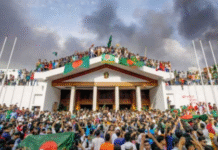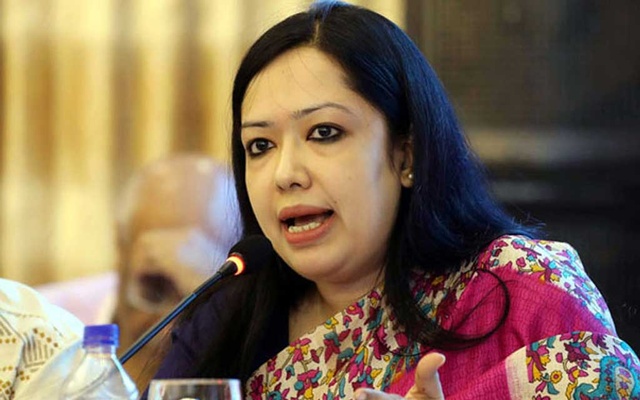TBS

During the tenure of the previous government, most projects sourced granite from India. But if it is high-quality granite that the projects required, they could have easily sourced it from a local source instead of depending on imports.
Take the stones extracted from the Maddhapara Granite Mining Company, for instance. According to company officials, their granite is of superior quality. Yet for road construction, railway projects, and even projects under the Bangladesh Water Development Board (BWDB), Maddhapara’s stones were sidelined in favour of imported, inferior-quality Indian stones.
As a result, in 2024 alone, the country’s sole granite mine faced losses of nearly Tk30 crore.
“The road you used to get here — the stones used to build it were also imported from India. Yet, tonnes of stone are lying idle here in our stockyard,” the mine’s Deputy General Manager Syed Rofizul Islam said, pointing to the sky-high piles of stones.
According to him, the Maddhapara mine, located in Parbatipur upazila of Dinajpur district, has set a new production record for maximum stone extraction.
Operated by Maddhapara Granite Mining Company under Petrobangla, the mine’s monthly production target is 124,000 tonnes. However, over the past eight months, extraction has exceeded the target by nearly 400,000 tonnes.
An end to AL era stonewalling of deals
“Bangladesh’s annual demand for stone is 21.6 million tonnes. The majority of this is imported from India, Bhutan and Dubai. A small quantity is sourced locally from the Mahananda River in Panchagarh and the Bholaganj area of Sylhet, but this is negligible in comparison,” Rofizul Islam noted.
“Despite the international-standard quality of stone extracted from the country’s only underground mine here at Maddhapara, various excuses were made to avoid using it in major projects, particularly during the previous government’s tenure,” he added.
Rofizul Islam stated, “We are hopeful that this year we will be able to turn a profit. For a long time, our two primary clients — Bangladesh Railway and the Bangladesh Water Development Board — had stopped purchasing our stone due to pressure from the previous government.
“Now, they are reconnecting with us to procure stones again. Right now, we have almost Tk400 crores worth of stones stocked here. Once we release these stones, I am confident our company will return to profitability,” he added.
In a previous TBS report, several company officials reported that due to the unsold stock, they have had to borrow money to pay the mining contractor and cover salaries and allowances. In August last year, Tk30 crore was borrowed to settle dues with the contracting company.
“Bangladesh Railway takes a certain type of stone from us, and we currently have around 750,000 tonnes of it in stock. The railway authorities have already signed a contract to take 100,000 tonnes from us, of which they have collected 60,000. The Water Development Board will also begin taking stones from us soon,” he further said.

Currently, the mine has a stockpile of over 1.2 million tonnes of stone. Both the mining authority and the contractor have called upon stakeholders to use Maddhapara’s granite in ongoing national projects instead of importing stone from abroad.
According to available data, the Maddhapara mine currently extracts around 5,500 tonnes of stone daily — equivalent to over 1.5 million tonnes annually. However, annual sales are around 900,000 tonnes. Of the total extracted stone, 18% is 5–20 millimetres in size, 5% is 20–40 millimetres, 34% is 40–60 millimetres (blast), 11% is 60–80 millimetres, 17% is in boulder form, and 15% is stone dust (0–5 millimetres).
However, most construction works require stone sizes between 8 and 12 millimetres, which are not produced by the Maddhapara mine. Consequently, many users are compelled to use the 5–20 millimetre variety. Demand for this size exceeds the mine’s production capacity. On the other hand, 51% of total production consists of blast and boulder stones. Major buyers of blast and boulder stones include Bangladesh Railway, the Water Development Board, and LGED.
The mine’s stockpile as of 31 May 2025 includes 780,000 tonnes of blast stone suitable for railway use and 452,000 tonnes of boulders used in river training projects.
Stone dust sized 0-5mm is priced at Tk1,150 per tonne, 5-20mm stone at Tk3,250, 20-40mm at Tk3,600, 40-60mm at Tk3,650, 60-80mm at Tk2,600, boulder at Tk3,200, and fine dust at Tk740 per tonne.
Better quality, but higher price
Quarry officials and stone traders find Maddhapara’s complex marketing guideline discouraging for individual buyers, who are required to book stones in advance, pay cash at banks and arrange transportation on their own to carry stones from the mine.
The 2006 marketing guideline, revised in 2017, favours designated distributors and government agencies over others.
Traders say 5-20mm size stones imported from India are priced at Tk120-Tk130 per cubic foot, while the same size stone from Maddhapara costs Tk140 per cubic foot.
Company officials argue that increasing tariffs on imported stone and raising the tariff value of Maddhapara stone has become urgent.
Rofizul Islam commented, “It should be made mandatory to use Maddhapara stone in the projects of the Roads and Highways Department (RHD), Bridges Division, Civil Aviation Authority of Bangladesh (CAAB), Local Government Engineering Department (LGED), Public Works Department (PWD), Railway, and BWDB’s projects. This would not only save foreign currency but also ensure the sustainable development of the mine.”
Transportation behind lack of price competitiveness
A critical obstacle for Maddhapara is transportation.
The mine was once connected by a 65-kilometre dedicated railway line for stone transport, but this line became defunct within six months of operation as trucking took over. To make matters worse, 8.8 kilometres of the railway track were stolen in early 2023.
As a result, truckers dominate stone transportation, significantly driving up costs. Transport from Maddhapara to Dhaka costs Tk1,200 to Tk1,300 per tonne, and to Chattogram Tk2,100 to Tk2,200 per tonne — considerably higher than rail transport could offer.
Rofizul Islam stressed, “If the railway were restored, transport costs could be reduced to Tk400–500 per tonne for Dhaka and Tk900–1,000 per tonne for Chattogram.”









